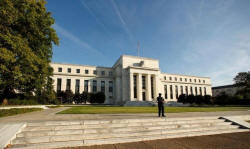Fed faces new challenge: A world without labor 'slack'
 Send a link to a friend
Send a link to a friend
 [April 30, 2018]
By Howard Schneider and Ann Saphir [April 30, 2018]
By Howard Schneider and Ann Saphir
WASHINGTON (Reuters) - Business is coming
in so fast and workers are in such high demand at AOW Associates Inc, an
Albany, New York-based construction firm, that its chief financial
officer hired a guy six weeks ago for a job that didn't exist.
"We keep our project management ads continuous, even if we are not
looking to fill a particular role, and if someone does come along, we
make a job for them," AOW CFO Nicki Armsby said in a recent interview.
The company is not alone in looking for creative ways to deal with a
U.S. labor shortage that, according to recent economic data and
documents from the U.S. Federal Reserve, may be getting worse.

Policymakers at the Fed, which holds its latest policy meeting this
week, must now decide what weight to give to signs that the economy is
reaching a point where wages, inflation and other laggard indicators may
turn higher.
Data on Friday showed U.S. employment costs rose in the first quarter at
an annualized rate of 4 percent, continuing what JP Morgan economists
view as a steady march higher since the unemployment rate fell below 5
percent in 2015. [nL1N1S41BF]
Investors appear to be betting on that scenario playing out. The yield
on the benchmark 10-year U.S. Treasury note breached the 3 percent level
last week for the first time in more than four years.
And labor shortages have been cited by analysts as being responsible for
the growing backlogs for manufactured goods in recent supply manager
reports.
Add in the fiscal stimulus from the Trump administration's tax cuts and
spending that is hitting the economy this year, and the higher prices
for aluminum, steel and potentially other goods triggered by new import
tariffs, and the tenor of upcoming Fed analysis could be poised to
shift.
"Demand has stayed very strong," said Tim Fiore, who heads the Institute
of Supply Management's manufacturing business survey committee. "There
is plenty for a strong expansion ... Dig into the details and the
employment side has clearly been constricting producers' ability to meet
demand."
The Fed is not expected to raise interest rates at the end of its
two-day policy meeting on Wednesday. It also is not releasing updated
economic forecasts and Fed Chairman Jerome Powell is not scheduled to
hold a press conference.

The policy statement alone could show how policymakers have accounted
for a range of recent developments, and how their thinking may have
evolved since the last meeting in March, when the U.S. central bank
raised rates.
[to top of second column] |

A police officer keeps watch in front of the U.S. Federal Reserve
building in Washington, DC, U.S. on October 12, 2016. REUTERS/Kevin
Lamarque/File Photo

According to documents released in the interim, the wages and inflation debate
within the Fed appears to be shifting.
In the minutes from the March 20-21 meeting, released earlier this month, the
word "slack" was jettisoned in the discussion of labor markets, a notable change
in what has been a staple description of labor conditions during the current
economic expansion.
The Fed then said in its "Beige Book" report, also released this month, that
entrepreneurs across broad sectors of the economy were struggling to fill both
skilled and unskilled jobs.
"The labor market is tight and continuing to tighten," Erin Browne, head of
asset allocation at UBS Asset Management, said on Friday after the Labor
Department released the latest employment cost data.
"We are finally starting to see that translate into wage inflation."
MISSING PIECE
Although inflation has remained below the Fed's 2 percent medium-term target for
years, there appears to be growing confidence among policymakers that the pace
of price increases will not collapse again and that the objective will be
reached.
"They no longer see downside risk to inflation," said Ed Al-Hussainy, senior
interest rate and currency analyst for Columbia Threadneedle Investments.

Data from CME Group and Eurodollar futures still point to just two more rate
hikes this year, though many economists argue the Fed will ultimately raise
rates on a quarterly basis from here on, leading to three more hikes by the end
of 2018.
The direction of wage growth will be critical to the Fed's assessment, with
Powell citing it as the missing piece in the discussion of whether "full
employment" has truly been reached or exceeded. That, in turn, will shape the
debate about whether the Fed may even need to move faster and further than
expected with its monetary tightening.
If the choice is coming between raising compensation and leaving money on the
table in the form of unfilled orders, then the weight may be shifting.
(Reporting by Howard Schneider and Ann Saphir; Editing by Paul Simao)
[© 2018 Thomson Reuters. All rights
reserved.] Copyright 2018 Reuters. All rights reserved. This material may not be published,
broadcast, rewritten or redistributed.
Thompson Reuters is solely responsible for this content. |